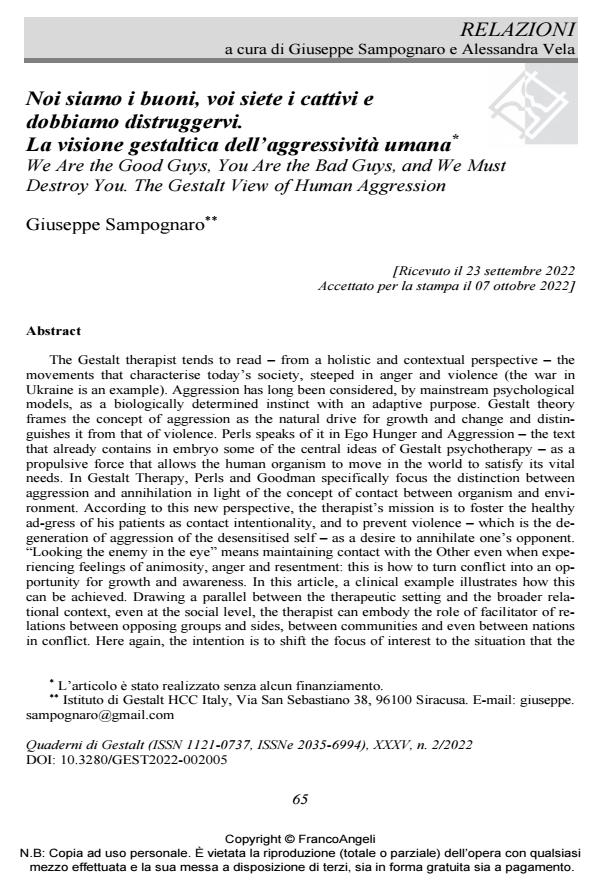We Are the Good Guys, You Are the Bad Guys, and We Must Destroy You. The Gestalt View of Human Aggression
Journal title QUADERNI DI GESTALT
Author/s Giuseppe Sampognaro
Publishing Year 2022 Issue 2022/2
Language Italian Pages 20 P. 65-84 File size 222 KB
DOI 10.3280/GEST2022-002005
DOI is like a bar code for intellectual property: to have more infomation
click here
Below, you can see the article first page
If you want to buy this article in PDF format, you can do it, following the instructions to buy download credits

FrancoAngeli is member of Publishers International Linking Association, Inc (PILA), a not-for-profit association which run the CrossRef service enabling links to and from online scholarly content.
The Gestalt therapist tends to read - from a holistic and contextual perspective - the movements that characterise today’s society, steeped in anger and violence (the war in Ukraine is an example). Aggression has long been considered, by mainstream psychological models, as a biologically determined instinct with an adaptive purpose. Gestalt theory frames the con-cept of aggression as the natural drive for growth and change and distinguishes it from that of violence. Perls speaks of it in Ego Hunger and Aggression - the text that already contains in embryo some of the central ideas of Gestalt psychotherapy - as a propulsive force that allows the human organism to move in the world to satisfy its vital needs. In Gestalt Therapy, Perls and Goodman specifically focus the distinction between aggression and annihilation in light of the concept of contact between organism and environment. According to this new perspective, the therapist’s mission is to foster the healthy ad-gress of his patients as contact intentionality, and to prevent violence - which is the degeneration of aggression of the desensitised self - as a desire to annihilate one’s opponent. "Looking the enemy in the eye" means maintaining con-tact with the Other even when experiencing feelings of animosity, anger and resentment: this is how to turn conflict into an opportunity for growth and awareness. In this article, a clinical example illustrates how this can be achieved. Drawing a parallel between the therapeutic set-ting and the broader relational context, even at the social level, the therapist can embody the role of facilitator of relations between opposing groups and sides, between communities and even between nations in conflict. Here again, the intention is to shift the focus of interest to the situation that the disputants are experiencing, to what unites them and their relationship. If the basic principle becomes the mutual recognition of all those experiencing the conflict in the giv-en context, it is impossible to desire the destruction of the Other and to take pleasure in it.
Keywords: Aggression, violence, conflict, situation, contact.
Giuseppe Sampognaro, Noi siamo i buoni, voi siete i cattivi e dobbiamo distruggervi. La visione gestaltica dell’aggressività umana in "QUADERNI DI GESTALT" 2/2022, pp 65-84, DOI: 10.3280/GEST2022-002005